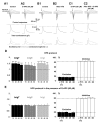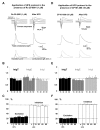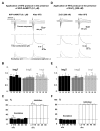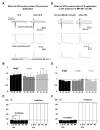Involvement of NR2A- or NR2B-containing N-methyl-D-aspartate receptors in the potentiation of cortical layer 5 pyramidal neurone inputs depends on the developmental stage
- PMID: 17650107
- PMCID: PMC2533738
- DOI: 10.1111/j.1460-9568.2007.05671.x
Involvement of NR2A- or NR2B-containing N-methyl-D-aspartate receptors in the potentiation of cortical layer 5 pyramidal neurone inputs depends on the developmental stage
Abstract
In the cortex, N-methyl-D-aspartate receptors (NMDARs) play a critical role in the control of synaptic plasticity processes. We have previously shown in rat visual cortex that the application of a high-frequency stimulation (HFS) protocol used to induce long-term potentiation in layer 2/3 leads to a parallel potentiation of excitatory and inhibitory inputs received by cortical layer 5 pyramidal neurones without changing the excitation/inhibition balance of the pyramidal neurone, indicating a homeostatic control of this parameter. We show here that the blockade of NMDARs of the neuronal network prevents the potentiation of excitatory and inhibitory inputs, and this result leaves open to question the role of the NMDAR isoform involved in the induction of long-term potentiation, which is actually being strongly debated. In postnatal day (P)18-23 rat cortical slices, the blockade of synaptic NR2B-containing NMDARs prevents the induction of the potentiation induced by the HFS protocol, whereas the blockade of NR2A-containing NMDARs reduced the potentiation itself. In P29-P32 cortical slices, the specific activation of NR2A-containing receptors fully ensures the potentiation of excitatory and inhibitory inputs. These results constitute the first report of a functional shift in subunit composition of NMDARs during the critical period (P12-P36), which explains the relative contribution of both NR2B- and NR2A-containing NMDARs in synaptic plasticity processes. These effects of the HFS protocol are mediated by the activation of synaptic NMDARs but our results also indicate that the homeostatic control of the excitation/inhibition balance is independent of NMDAR activation and is due to specialized recurrent interactions between excitatory and inhibitory networks.
Figures





References
-
- Abraham WC, Huggett A. Induction and reversal of long-term potentiation by repeated high-frequency stimulation in rat hippocampal slices. Hippocampus. 1997;7:137–145. - PubMed
-
- Anderson JS, Carandini M, Ferster D. Orientation tuning of input conductance, excitation, and inhibition in cat primary visual cortex. J Neurophysiol. 2000;84:909–926. - PubMed
-
- Auberson YP, Allgeier H, Bischoff S, Lingenhoehl K, Moretti R, Schmutz M. 5-Phosphonomethylquinoxalinediones as competitive NMDA receptor antagonists with a preference for the human 1A/2A, rather than 1A/2B receptor composition. Bioorg Med Chem Lett. 2002;12:1099–1102. - PubMed
-
- Babb TL, Mikuni N, Najm I, Wylie C, Olive M, Dollar C, MacLennan H. Pre- and postnatal expressions of NMDA receptors 1 and 2B subunit proteins in the normal rat cortex. Epilepsy Res. 2005;64:23–30. - PubMed
MeSH terms
Substances
LinkOut - more resources
Full Text Sources
Research Materials

